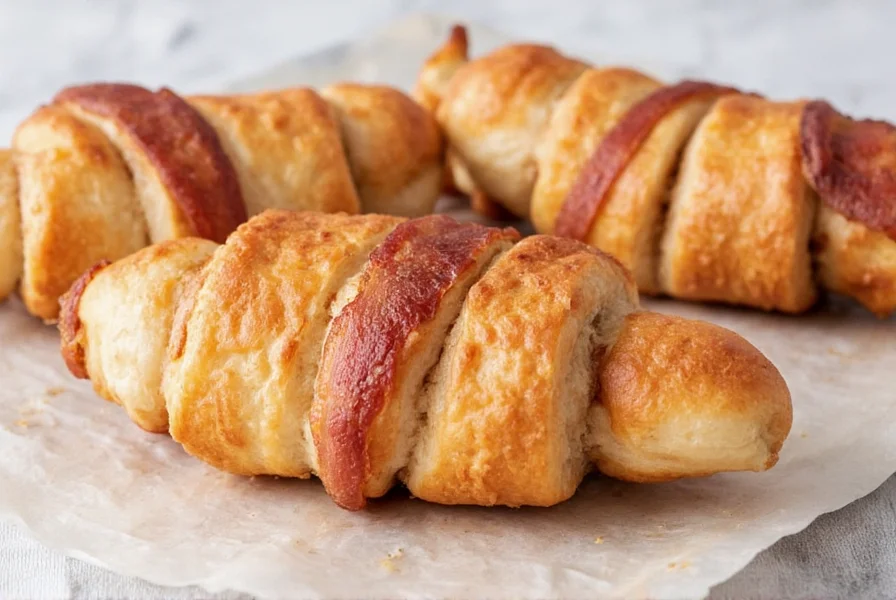The Ultimate Guide to Perfect Bacon Cinnamon Roll Twists
Bacon cinnamon roll twists have become a beloved breakfast innovation, merging two classic favorites into one show-stopping pastry. Unlike traditional cinnamon rolls, these twisted creations incorporate bacon directly into the dough structure, creating pockets of savory goodness that contrast beautifully with the sweet cinnamon filling. Professional bakers appreciate how the bacon adds both flavor complexity and textural contrast to the soft, pillowy dough.
Why This Recipe Works
What sets exceptional bacon cinnamon roll twists apart from ordinary versions? The magic happens through three key elements: proper bacon preparation, ideal dough consistency, and strategic twisting technique. Many home bakers make the mistake of adding raw bacon directly to the dough, which leads to uneven cooking and greasy results. The professional approach involves partially cooking the bacon first to render excess fat while maintaining enough flexibility for weaving into the dough.
| Ingredient | Traditional Rolls | Bacon Twists Variation |
|---|---|---|
| Dough Type | Enriched yeast dough | Same base with added bacon fat |
| Filling | Cinnamon-sugar only | Cinnamon-sugar with bacon bits |
| Structure | Swirled log | Weaved bacon lattice |
| Texture Profile | Uniform softness | Crunchy bacon with soft dough |
Essential Ingredients for Homemade Bacon Cinnamon Roll Twists
Creating bakery-quality bacon cinnamon roll twists starts with selecting the right ingredients. While you can use store-bought dough for convenience, homemade dough yields superior texture and flavor control. For the bacon component, choose thick-cut bacon with consistent marbling—this provides the ideal balance of crispiness and flexibility needed for weaving into the dough.
Dough components:
- 3 1/4 cups all-purpose flour (plus extra for dusting)
- 1/4 cup granulated sugar
- 2 1/4 tsp active dry yeast
- 1/2 cup whole milk, warmed
- 1/4 cup unsalted butter, melted
- 1 large egg
- 1/4 tsp salt
Filling and assembly:
- 6 strips thick-cut bacon
- 1/2 cup packed brown sugar
- 2 tbsp ground cinnamon
- 3 tbsp softened butter
- 1/4 cup chopped cooked bacon
Cream cheese frosting:
- 4 oz cream cheese, softened
- 1/4 cup powdered sugar
- 2 tbsp milk
- 1/2 tsp vanilla extract

Step-by-Step Preparation Guide
Follow these professional techniques to achieve perfectly twisted bacon cinnamon rolls every time:
- Prepare the bacon: Cook bacon until partially done (about 5-6 minutes). Drain on paper towels, reserving 1 tablespoon of bacon fat for the dough. Chop 1/4 cup for filling.
- Mix the dough: Combine warm milk, sugar, and yeast. Let sit for 5 minutes until foamy. Add egg, melted butter (including reserved bacon fat), and salt. Gradually mix in flour until a soft dough forms.
- Knead and rise: Knead dough for 5-7 minutes until smooth and elastic. Place in greased bowl, cover, and let rise for 1-1.5 hours until doubled.
- Roll and fill: Roll dough into a 16x12 inch rectangle. Spread softened butter evenly, then sprinkle with cinnamon-sugar mixture and chopped bacon.
- Weave the bacon: Lay partially cooked bacon strips horizontally across dough, spacing 1 inch apart. Starting from one end, fold alternating strips over and under to create a lattice pattern.
- Twist and shape: Roll dough tightly from the long side. Cut into 12 equal pieces. Take each piece and twist gently before placing in greased baking pan.
- Final rise and bake: Cover and let rise 30 minutes. Bake at 375°F for 20-25 minutes until golden brown.
- Frost: Mix frosting ingredients and drizzle over cooled rolls.
Professional Baking Tips for Success
Mastering bacon cinnamon roll twists requires attention to specific details that many recipes overlook. Temperature control proves critical at multiple stages—yeast dough performs best when ingredients stay between 75-80°F. When weaving the bacon lattice, work quickly before the dough warms too much, as cooler dough maintains better structure during twisting.
For gluten-sensitive guests, substitute with a 1:1 gluten-free flour blend and add 1/2 teaspoon xanthan gum to the dough. Vegan adaptations work well using plant-based butter, flax egg (1 tbsp ground flax + 3 tbsp water), and coconut cream cheese frosting.
Avoid these common mistakes that ruin bacon cinnamon roll twists:
- Using fully cooked bacon (becomes too brittle for weaving)
- Overfilling with cinnamon sugar (causes leakage during baking)
- Skipping the final rise (results in dense, chewy texture)
- Applying frosting while rolls are too hot (melts into dough)
Variations to Try
Once you've mastered the basic technique, experiment with these creative adaptations:
- Savory-Sweet Maple: Add 2 tablespoons maple syrup to the filling and top with candied pecans
- Breakfast Combo: Incorporate crumbled breakfast sausage into the filling layer
- Mini Twists: Make bite-sized versions using a muffin tin for party-friendly portions
- Spiced Apple: Add 1/2 cup finely diced apples to the filling mixture
For special occasions, consider making overnight bacon cinnamon roll twists. After shaping but before the final rise, cover the pan and refrigerate for up to 12 hours. Remove from refrigerator 30 minutes before baking to allow proper rising.

Serving and Storage Recommendations
Bacon cinnamon roll twists deliver peak flavor when served warm, within 2-3 hours of baking. For optimal texture, let them cool for 15 minutes before applying frosting—this allows the surface to set slightly while maintaining warmth that helps the frosting melt perfectly.
Store leftovers in an airtight container at room temperature for up to 2 days. For longer storage, freeze individual twists on a baking sheet, then transfer to freezer bags for up to 3 months. Reheat frozen twists by thawing at room temperature for 30 minutes, then warming in a 300°F oven for 8-10 minutes.
Frequently Asked Questions
Can I use pre-cooked bacon for bacon cinnamon roll twists?
Yes, but with modifications. Fully cooked bacon becomes too brittle for weaving. Instead, partially cook bacon (about 5-6 minutes) until flexible but not crisp. This allows proper weaving while ensuring complete cooking during the baking process.
How do I prevent the bacon from making my cinnamon roll twists greasy?
To avoid greasiness, partially cook the bacon first to render excess fat, then pat dry with paper towels. Reserve about 1 tablespoon of bacon fat to incorporate into the dough instead of butter, which enhances flavor without adding extra grease.
What's the best way to reheat bacon cinnamon roll twists?
For optimal texture, reheat in a 300°F oven for 8-10 minutes rather than using a microwave. This restores the flakiness of the pastry while maintaining the crispness of the bacon. If frozen, thaw for 30 minutes first before reheating.
Can I make bacon cinnamon roll twists ahead of time for brunch?
Absolutely. Prepare the twists through the shaping step, then cover and refrigerate overnight. Remove from refrigerator 30 minutes before baking to allow proper rising. This method actually improves flavor development while saving morning preparation time.
Why did my bacon cinnamon roll twists come out dense?
Dense texture typically results from insufficient rising time, over-kneading the dough, or baking at too low a temperature. Ensure your yeast is fresh, allow proper rising until doubled in size, and verify your oven temperature with an independent thermometer.











 浙公网安备
33010002000092号
浙公网安备
33010002000092号 浙B2-20120091-4
浙B2-20120091-4